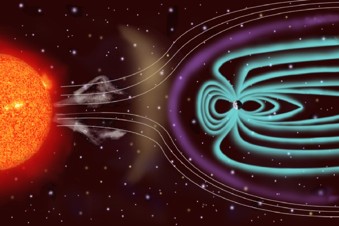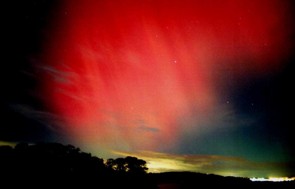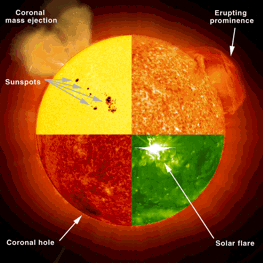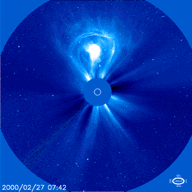Sun-Earth Connections: Introduction to the Science: Space Weather and Geomagnetic Storms
Understanding space weather begins with an understanding of some of the properties of the Sun, in particular, its magnetic activity cycle. Solar magnetic activity has both a long-term cyclical nature, for example as measured by the numbers of sunspots over time spans of decades to centuries, and a sporadic, eruptive component, involving the rapid ejection of matter and energy from the Sun into space. This eruptive component is usually associated with terms such as coronal mass ejection (CMEs), solar flare and active region (sunspots). The number of eruptive events at any time broadly follows the long-term magnetic cycle, but large events can occur even when the Sun appears magnetically 'quiet'.
The solar drivers of geomagnetic storms are CMEs and coronal holes. Observations of these phenomena are made by solar observatories on the ground, for example at the High Altitude Observatory and Big Bear Observatory, and in space, using instruments such as those onboard the NASA/ESA SOHO spacecraft.
The sunspot cycle is a result of a dynamo operating deep in the solar atmosphere at the interface between the convection and radiative zones. This dynamo reverses polarity approximately every eleven years, with a range of nine to fourteen years having been observed. Ultimately, even the short-lived CMEs and coronal holes are caused by the magnetic stresses built up as the solar cycle develops and the resulting reorganisation of the large-scale solar magnetic field. Geomagnetic activity and hence the geomagnetic hazard is usually more pronounced during the peak in the solar cycle when there are most sunspots, but big magnetic storms can actually occur anytime, even when there are few sunspots.
The ever-present supersonic solar wind carries the Sun's magnetic field into space as the interplanetary magnetic field. Travelling CMEs and fast streams of solar wind from coronal holes sweep through and interact with this ambient solar wind flow. The NASA/NOAA satellite ACE measures disturbances in the wind from a point, some 1.5 million kilometres 'upwind' from the Earth, in the direction of the Sun.
Although the solar wind is very tenuous, a combination of fast wind speeds and an interplanetary magnetic field that points in the direction of the Earth's south magnetic pole, drives electrical currents throughout the Earth's magnetosphere. These currents produce the geomagnetic variations and geomagnetic storms that we measure using magnetometers both in the UK and worldwide. Storms also produce the Aurora Borealis, or 'Northern Lights', in the Earth's atmosphere, more commonly at higher latitudes (typically poleward of about 60 degrees). The Aurora also occurs in the Southern hemisphere, as the Aurora Australis. The colours of the aurora are characteristic of the light emitted when energetic charged particles strike atmospheric gases such as oxygen (green) and nitrogen (red) at altitudes of around 100km. Its a process not dissimilar to that in a standard fluorescent bulb.
Even when the conditions in interplanetary space are not right for major geomagnetic activity, enhanced geomagnetic variations can still take place because of the energy previously stored in some of the magnetospheric current systems by the solar wind. This kind of geomagnetic activity may occur intermittently during local night time hours, often accompanied by more limited displays of the 'Northern Lights'.



- Global Geomagnetic Models
- Space Weather and Geomagnetic Hazard
- High-frequency magnetometers
- Schumann Resonances
- Geoelectric field monitoring
- Space Weather Impact on Ground-based Systems (SWIGS)
- SWIMMR Activities in Ground Effects (SAGE)
- Geomagnetic Virtual Observatories
- Quantum magnetometers for space weather
- Magnetotellurics
- Publications List




